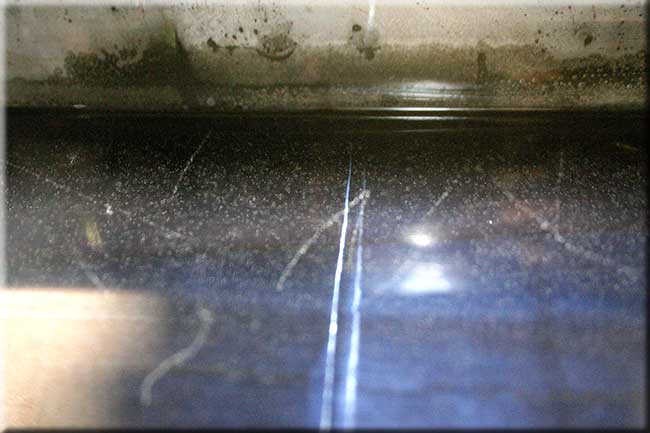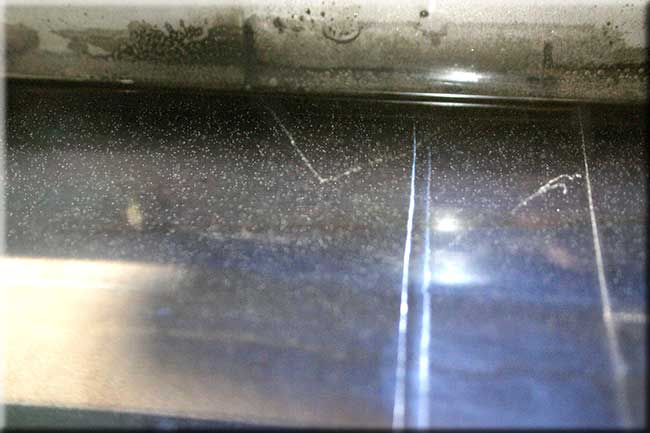|
We've included a couple of (the many hundreds of) photographs taken by Holly Batchelor and Maddy Clarke, our 2006 summer students, to illustrate some of the types of track which may be seen in the diffusion chamber.
The tracks were best seen under low ambient illumination conditions (covering the entire chamber and the viewer with a black cloth worked well! :-), and a black card cover for the entire tank, with only a rectangular cutout at the front for viewing, and a small opening at the back, through which a torch beam could be shone, to highlight the vapour layer, as you can see in the images below. (It took some time to find exactly the right angle for the incident beam; once that was done the torch was clamped to a retort stand.)
Images were taken with a camera on a tripod, using a shutter speed of around 1/16 second, and a low film speed (1600 ASA, CCD equivalent). Anything longer than 1/16s tended to blur the trails too much (the vapour layer is continually sinking, so the trails break up almost immendiately), so the aperture had to be pretty wide (f5.0), and the depth-of-field is poor. (Some tracks are sharply defined, but others are more blurred, alas.)
|
|
|
| Image 1, above (click for the full-size image on a separate page): This picture shows the anodised aluminium baseplate and the rear wall of the plastic chamber tank. (The two bright lines running approximately down the centre of the plate are an artifact of the anodising process. (The plate had to part-anodised in two halves, because it wouldn't fit into the bath.)
The speckled pattern across the picture above is the slowly-sinking vapour layer, illuminated by the torch, and the short line segments are the tracks left by particles. (If you look at the full-size image you can more easily see the droplets which form the trails. The long, diagonal track entering from mid-left is a fast-moving particle, which doesn't appear to interact with anything in the tank. Slower-moving particles, and ones which collide with atoms in the vapour, leave thicker, more irregular paths. (The blurred one at front-left is striking.)
The picture above is particularly busy; in most of the photographs there were only single tracks, or nothing at all. The image below, however shows what appear to be interesting events...
|
|
|
|
|
| Image 2: Here we see three tracks of interest. (Again, click on the picture, or here, for a larger picture on a separate page.)
First, the chevron-shaped track in the approximate centre of the image. It appears to be one complete track, rather than two, coincidentally superimposed ones. (The bubbles at the point of the V have the same blur on each track, suggesting that the point of the V is where both tracks meet.) This, therefore, may be the track of a muon, in which it decays into an electron and two neutrinos (which aren't charged, and don't leave a track).
Another interesting track is the slightly claw-shaped one on the right, looking a bit like ET's hand. It could be evidence of a particle 'knocking on' an electron from an atom in the tank's air/vapour mix; both particles then stagger on for a bit, colliding with surrounding atoms, leaving two thick, wiggly paths.
Finally, the track on the far-right, which highlights the poor depth of field of the image! It shows a high-velocity particle, which presumably enters from the rear of the tank, describes an almost horizontal path through the vapour, appearing to knock on another particle (the blurred track which heads off to the right), before exiting at the front of the tank, its path hardly disturbed.
Not bad, for a plastic box, some IPA and a hot water bottle...
|
Click here to return to the cloud chamber page.
|









